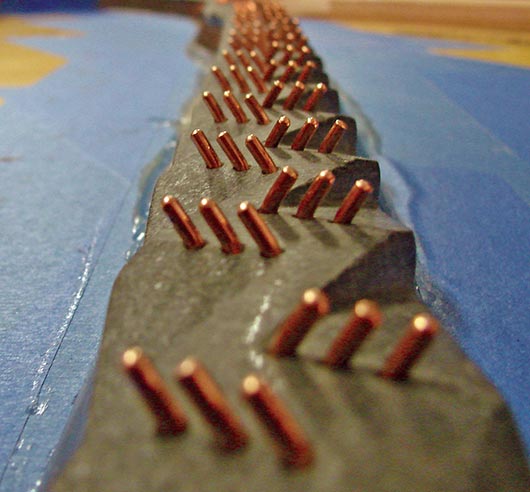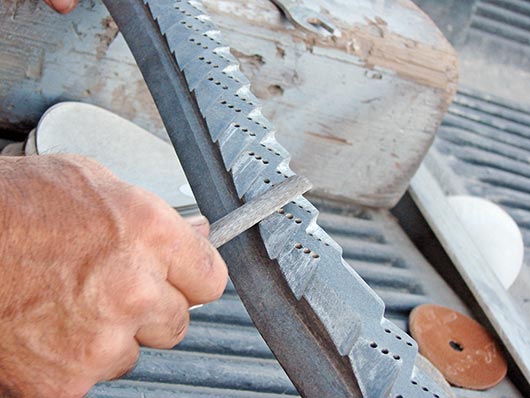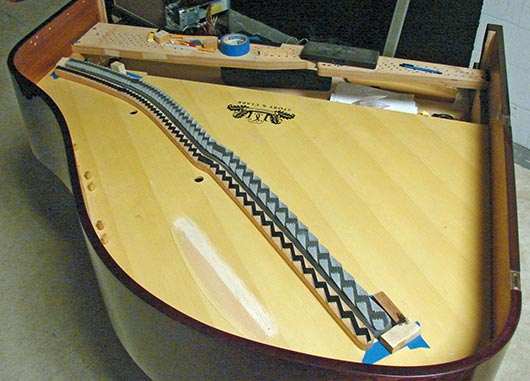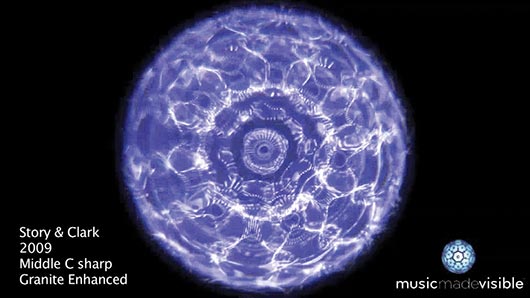At Stonetone Music, the Granite Speaks for Itself
Stacy B. Williams
Special Correspondent
 The Slippery Rock recently caught up with stone mason and inventor Robert DiSanto and pianist Dr. Richard Bosworth of Stonetone® Music, Inc. in Naples, Florida.
The Slippery Rock recently caught up with stone mason and inventor Robert DiSanto and pianist Dr. Richard Bosworth of Stonetone® Music, Inc. in Naples, Florida.
They have been quite busy over the last year and a half, but have made significant progress in the research phase of their granite piano bridge prototype.
This means they have been asking a lot of questions.
 Being the meticulous artists that they are, Stonetone® is strategically making headway into the piano industry one question at a time. Although the experimental process is still in its inception, the response to the Stonetone® modified pianos has been overwhelmingly positive.
Being the meticulous artists that they are, Stonetone® is strategically making headway into the piano industry one question at a time. Although the experimental process is still in its inception, the response to the Stonetone® modified pianos has been overwhelmingly positive.
 The two prototypes have performed extremely well in two recent experiments: one for a live audience of piano technicians and one for a Cymascope, an impressive scientific instrument that creates images of sound waves.
The two prototypes have performed extremely well in two recent experiments: one for a live audience of piano technicians and one for a Cymascope, an impressive scientific instrument that creates images of sound waves.
 In September, DiSanto and Bosworth had an in-depth meeting with some of the top piano technicians in the Midwest at the PianoForte Foundation in Chicago. Their second prototype, the Story and Clark baby grand, was the showcase piece at the presentation. After three and a half weeks on the road from Naples, the Story and Clark finally arrived in Chicago ready for its debut.
In September, DiSanto and Bosworth had an in-depth meeting with some of the top piano technicians in the Midwest at the PianoForte Foundation in Chicago. Their second prototype, the Story and Clark baby grand, was the showcase piece at the presentation. After three and a half weeks on the road from Naples, the Story and Clark finally arrived in Chicago ready for its debut.
“I think it stopped in every major city along the way and it didn’t go out of tune!” exclaimed DiSanto.
Thomas Zoells, Founder and Executive Director of the PianoForte Chicago, said the meeting was “a lively one with many questions.” It was an important learning experience for everyone involved.
After the presentation, many of the audience members (some of whom are pianists turned technicians) had the opportunity to test the entry-level Story and Clark against a handmade 7 1/2-foot Shigeru Kawai, known in the industry as a luxury piano. DiSanto said that this comparison was not ideal because it was like comparing a Corvette and a Pinto, but the difference was still incredibly pronounced.
“There were a lot of wide eyes,” said Bosworth, “It was just one Kodak moment after another.”
Piano tuner and technician Daniel Koehler, agrees, along with his colleagues, that granite bridges are superior in their sustaining quality. What the granite bridge can do for the piano sound pattern is the key to its success.
DiSanto explains that the sound pattern of wood bridges is attack, decay, sustain, release (ADSR). But with a granite bridge, the pattern becomes attack, sustain, decay, release (ASDR). So by sustaining the initial attack of the notes in a chord, one is able to hear all the tones for the same length of time rather than the treble range dying out first.
“The finest pianos have this laser-beam kind of tone, with a clean crisp sound, much like a vocal, dolce sweet quality,” says Bosworth, an acclaimed pianist.
StoneTone®’s exciting mission to create this kind of tone by using a modified granite bridge has passed several tests with flying colors, (specifically a purple hue) as seen in a Cymascope test (see photo).
They commissioned this Cymascope test with six different piano samples: four of them with wood bridges and StoneTone®’s two prototypes.
The Cymascope still image of the middle C-sharp note on the Story and Clark looks like a pretty fractal, but it actually represents all the harmonic overtones associated with that string as shown by the sustainability of the note.
The outer edges of the imprint express the principal sounding tone (middle C-sharp) and the center shapes express the overtone series (secondary pitches vibrating in fractional ratios, which add the color to the sound), DiSanto explains. Therefore, the granite is capable not only of sustaining the note, but it also allows the “full bouquet” to be heard more clearly.
Stonetone® deservedly feels confident moving forward as they are able to hear and scientifically see the difference between the traditional wood bridge and their granite bridge. There are numerous advantages to the increased presence of partial tones in each key, allowing more intricate pieces like polyphonic music to be heard in a refined manner.
Polyphonic music is composed of several independent voices or instruments constructed in a simultaneous manner. Johann Sebastian Bach is famous for these polyphonic compositions, and with a modified granite bridge, people may actually be able to hear them as they were written.
Bosworth admits that he has become more interested in playing polyphonic pieces on the Stonetone® prototypes because of the multilayered sound quality.
“Think of it like a can of worms… you follow one worm and there’s another one on top of that one,” says Bosworth, “so you hear these different musical lines, where one is going and you can hear another one underneath it, and all these subtleties of how the different tones relate to each other.”
The research team will continue to use volcano absolute black granite in their prototypes until, by process of elimination, they can conclude what the most superior granite may be for sustaining sound quality in the test pianos. Absolute black granite, with its amazing strength and high level of density, is an ideal benchmark because of its unalterable qualities.
“Whether I purchased a slab today or forty years from now, it would still be the consistent mineral that it is,” says DiSanto.
DiSanto knows a thing or two about stone, but Stonetone® is interested in networking with experts across related fields. He has been in communication with Dr. Stanley Starr and Dr. Robert Youngquist of the NASA Kennedy Space Center about the energy of sound and its relationship to stone.
Both experts (a physicist and a geologist, respectively) agree that granite is the best transducer to get the string energy to the soundboard, which is the amplifier of the instrument, says DiSanto. Youngquist and Starr have been encouraging of the Stonetone® technology.
Moving forward, Stonetone® agrees that one of the biggest challenges will be re-educating the public on the preconceptions of what is an optimal musical material and why. Traditionally, the piano maker’s mantra is “If it’s not wood, it’s not good.” And as StoneTone’s concept development continues to defy that statement, they may also want to prove to the stone industry that granite is ideal for sound.
If any people are prepared to tackle this project, it is the team of DiSanto (inventor), Bosworth (media relations and performer) and Koehler (piano technician). Their combined expertise and passion for stone, music and mechanics creates the perfect recipe for this musical mission.
At this point, a myriad of possibilities await the Stonetone® crew, and they all agree there is a long process of elimination ahead.
“That’s where the exciting part comes in, because there’s a lot to discover,” says DiSanto.
As for the modified Story and Clark piano, it will sit humbly on display in Chicago waiting for someone to play its keys. After all the questions that have been posed, the granite continues to speak for itself.
Zoells has shown the Stonetone® modified Story and Clark to select pianists and technicians. Soon the piano will be moved to the main showroom next to a similar entry-level wood bridge piano to order to truly exhibit the differences. The Stonetone® modified piano will stay on display at the PianoForte Foundation until February 2013.
Zoells believes that with a little more research and development to refine the granite bridge design in a higher quality piano, it is likely that manufacturers could adopt this technology to enhance their pianos.
“What effect it might have on high quality pianos remains to be seen,” says Zoells.
Like the strings of the Stonetone® modified Story and Clark, I guess we’ll just stay tuned.
For more information, contact Dr. Richard Bosworth, Media Relations for Stonetone® Music, Inc. at richard@richardbosworth.org or 239-919-6414.
Watch the Cymascope middle C-sharp test on www.youtube.com